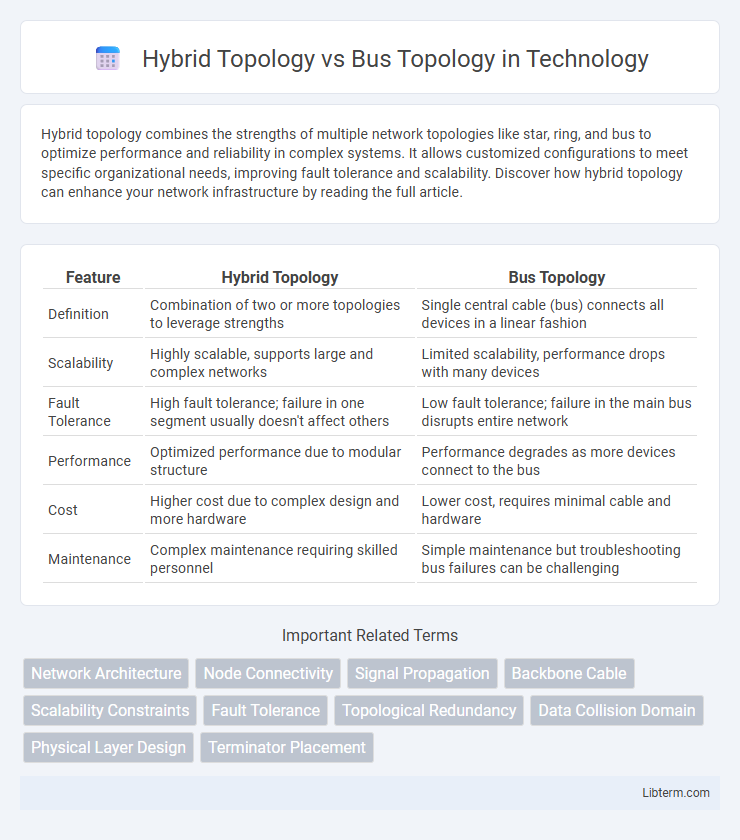Hybrid topology combines the strengths of multiple network topologies like star, ring, and bus to optimize performance and reliability in complex systems. It allows customized configurations to meet specific organizational needs, improving fault tolerance and scalability. Discover how hybrid topology can enhance your network infrastructure by reading the full article.
Table of Comparison
| Feature | Hybrid Topology | Bus Topology |
|---|---|---|
| Definition | Combination of two or more topologies to leverage strengths | Single central cable (bus) connects all devices in a linear fashion |
| Scalability | Highly scalable, supports large and complex networks | Limited scalability, performance drops with many devices |
| Fault Tolerance | High fault tolerance; failure in one segment usually doesn't affect others | Low fault tolerance; failure in the main bus disrupts entire network |
| Performance | Optimized performance due to modular structure | Performance degrades as more devices connect to the bus |
| Cost | Higher cost due to complex design and more hardware | Lower cost, requires minimal cable and hardware |
| Maintenance | Complex maintenance requiring skilled personnel | Simple maintenance but troubleshooting bus failures can be challenging |
Introduction to Network Topologies
Hybrid topology combines multiple types of network topologies, such as star, ring, and bus, to optimize performance and scalability in complex network environments. Bus topology uses a single central cable, called a bus, to which all network devices are connected, offering simplicity and cost-effectiveness but limited fault tolerance. Hybrid topology enhances network reliability and flexibility by leveraging the strengths of various topologies, making it suitable for large and diverse organizational networks.
Overview of Bus Topology
Bus topology connects all devices through a single central cable called the bus or backbone. Data travels in one direction along this cable, making it easy to implement but susceptible to cable failures that can disrupt the entire network. Bus topology is cost-effective for small networks but offers limited scalability and troubleshooting challenges compared to hybrid topology.
Key Features of Hybrid Topology
Hybrid topology combines the strengths of star, bus, and ring topologies to enhance network flexibility and scalability. Its key features include improved fault tolerance through segment isolation, optimized performance by balancing traffic loads, and adaptability to different network requirements. This topology supports complex and large-scale networks by integrating diverse connection methods while reducing the impact of individual node failures.
Bus Topology: Advantages and Limitations
Bus topology offers a simple and cost-effective layout by connecting all devices along a single cable, making it easy to install and requiring less cable compared to other topologies. This topology is efficient for small networks with limited devices, but it faces limitations like signal degradation over long distances and limited fault tolerance, as a break in the main cable can disrupt the entire network. Troubleshooting is straightforward but network performance degrades as more devices are added, reducing scalability compared to hybrid topology options.
Hybrid Topology: Pros and Cons
Hybrid topology combines multiple network topologies such as star, ring, and bus, offering enhanced flexibility and scalability for complex network architectures. It provides improved fault tolerance and efficient traffic management by isolating faults within individual segments, but its design and maintenance can be more costly and complex compared to bus topology. While bus topology is simpler and cheaper for small networks, hybrid topology excels in performance and reliability for larger, heterogeneous environments.
Performance Comparison: Hybrid vs Bus Topology
Hybrid topology offers superior performance compared to bus topology by combining the strengths of multiple network structures, enhancing fault tolerance and minimizing data collision. Bus topology suffers from limited scalability and higher data traffic congestion due to its single communication line, resulting in slower efficiency as network size increases. Hybrid topology's flexible architecture supports better bandwidth management and faster data transmission, making it ideal for complex and large-scale network environments.
Scalability and Flexibility in Network Design
Hybrid topology offers superior scalability and flexibility compared to bus topology by combining multiple network structures to accommodate varying data loads and device types. Unlike bus topology, which relies on a single communication line limiting expansion and fault tolerance, hybrid topology allows seamless integration of new devices and technologies without disrupting the entire network. This adaptability makes hybrid topology ideal for complex, growing enterprises requiring customizable and robust network design solutions.
Cost Implications: Hybrid vs Bus Topology
Hybrid topology generally incurs higher initial costs due to its complex structure combining multiple topologies like star, ring, and bus, requiring more cabling and hardware. Bus topology offers lower upfront costs with minimal cabling and simpler setup, making it cost-effective for small networks but less scalable and prone to maintenance expenses if traffic increases. Long-term operational costs for hybrid topology can decrease as its robustness reduces downtime and maintenance, whereas bus topology may face escalating costs with network growth and troubleshooting.
Use Cases and Real-World Applications
Hybrid topology combines the strengths of various network topologies, making it ideal for large enterprises requiring scalable, flexible, and fault-tolerant communication systems, such as data centers and campus networks. Bus topology is commonly used in smaller, cost-sensitive environments like small offices or temporary networks where simplicity and ease of installation are prioritized, but it suffers from performance degradation with increased devices. Real-world applications of hybrid topology include telecommunications networks and large corporate LANs, whereas bus topology is found in legacy systems and small-scale local area networks.
Choosing the Right Topology for Your Network
Selecting the appropriate network topology depends on factors like scalability, fault tolerance, and cost. Hybrid topology combines the strengths of multiple configurations, enhancing performance and reliability, while bus topology offers simplicity and low installation costs but limited fault tolerance. For growing networks requiring flexibility and robustness, hybrid topology is often the superior choice compared to the linear structure of bus topology.
Hybrid Topology Infographic

 libterm.com
libterm.com